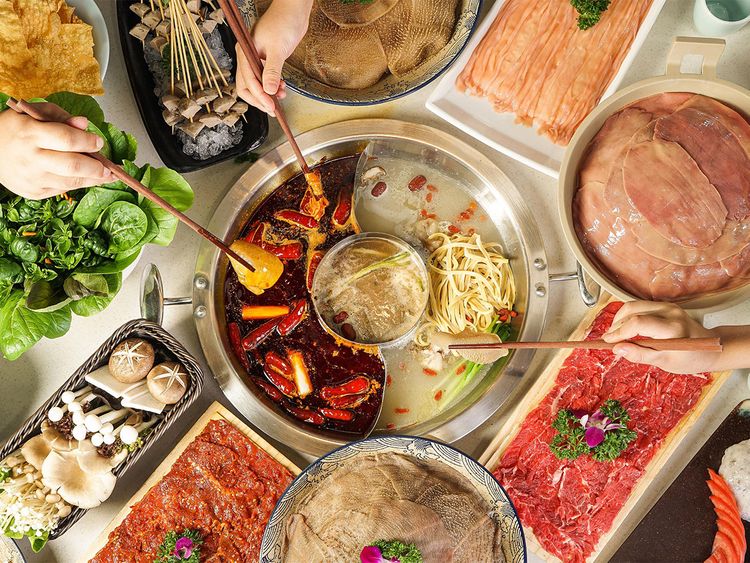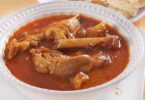Xuena Zhang
Dubai: ‘Hotpot’ is not what the Chinese call this popular dish. They call it ‘Fire Pot’ (Huo Guo), which sketches out the picture of a hotpot setting pretty well – simply put, you have a pot with food inside and a fire beneath the pot to cook the food. It’s essentially a dining experience where diners consume food that is cooked by them.
Three thousand years of cooking at the dining table, potentially
Academics hold different views over the origin of hotpot, said Donglin Wang, a professor in the Cultural Institute of Jiangxi Normal University, on ‘Lecture Room’, a Chinese television programme hosted by China Central Television, on which scholars from various disciplines are invited.
Wang thinks that the earliest prototype of hotpot is ‘You Pan Ding’, which existed in the Western Zhou Dynasty between 1046 BC and 771 BC. It translates to ‘Ding with a tray’ – ‘Ding’ is an ancient Chinese cooking utensil that is used for cooking and holding of food. It’s a pot with three legs, which stabilise the main body, and two ears, where you can grip and lift the pot up.
The difference between ‘Ding’ and ‘You Pan Ding’ is that ‘You Pan Ding’ has a tray attached to the three legs below the pot. Scholars think ancient Chinese people burned fuel on the tray to cook or heat what was inside the pot above of it, which is an identical concept to what hotpot is today.
Another saying is that hotpot emerged in the Three Kingdoms period (220 AD to 280 AD), as Wang pointed out. The founding emperor of one of the three kingdoms – the Wei Kingdom, Pi Cao, once asked his subordinate to create ‘Wu Shu Fu’, a pot comprising five compartments, so that five variants of food can be cooked in one pot concurrently – this corresponds to one of the characteristics of the modern-day hotpot, which is cooking food in compartments in a pot with different broths.

Why the trend of cooking and dining simultaneously
So, why did the idea of cooking and dining simultaneously emerge and become trendy?
Keep warm while eating during cold seasons
According to online reports, a rumoured story says that hotpot was a way to keep warm while eating during cold seasons. It’s said that Mongol warriors and horsemen used to circle around outside their camps to have dinner together. In the center of the circle, there was usually a pot over fire. So, they would cook and eat at the same time, while having a conversation with each other.
A simple and cheap way to cook
Others claim that it became trendy because it was a simpler and cheaper way to cook.
“There are also those who claim that hotpot was actually invented by boatmen in Chongqing who sought a simple and cheap way to cook,” wrote Manya Koetse, founder and editor-in-chief of ‘What’s on Weibo’ – an independent news site reporting social trends in China, in her article ‘What actually is ‘hotpot’’.
A fun communal dining experience
Hotpot is a social experience. So much is going on during a hotpot meal. First you sit down with a group of friends, then you need to discuss on what broth(s) base to pick, where you will cook your food in, as a group. Then, you move on to discuss what food, likely raw, to select, so both vegetarians and meat lovers in the group are content. After that, you team up and make your way to the ‘sauce station’, where dozens of sauces are at display – here is where you get creative, dare yourself with a combination of never-seen and never-heard-of Chinese sauces. If you are not the daring type, ask your Chinese friend or any member of the restaurant staff for suggestions, they are often knowledgeable on this.
What happens next is that you go back to your table with your dipping sauce, where your chosen broth(s) base and food have already been served. Now, you put your chosen food in the boiling broth(s), wait for them to be cooked while catching up with your friends. Some food, such as thinly sliced meat, is cooked in minutes. Some food, like dumplings, requires more cooking time. In the end, when all ingredients are in, you will have a pot of ‘mystery’, where you ‘discover’ ingredients that you’ve already forgotten about.
How famous is hotpot in China nowadays you ask? Imagine a hoppot restaurant covering an entire hillside, featuring 900 tables, with a capacity of nearly 6,000 diners at a time – we are talking about ‘Pi Pa Yuan’, the world’s largest hotpot restaurant in Chongqing.
According to a xinhuanet.com article, ‘Chinese hotpot is divided into “genres”. There are five major hotpot variants in China – Sichuan variant, Yunnan-Guizhou variant, Cantonese variant, Jiang-Zhe variant and northern variant.
Sichuan variant includes hotpot from Sichuan province and Chongqing city. They are currently the ‘hottest’ hotpot variant in China. It’s known for its intense combination of flavours and the tingling sensation, which is caused by one of its key ingredients – numb pepper. It pays attention to these four elements: numbness, spiciness, freshness and fragrance. The dipping sauce used in this region is sesame oil based.
Yunnan-Guizhou variant represents hotpot that is from Yunnan and Guizhou provinces. Yunnan’s geographical environment makes it the ideal place for various types of mushrooms to grow. So, mushroom-broth based hotpot is a local delicacy there. On the other hand, people from Guizhou province has mastered the skill of crafting dishes around the flavour of sourness.
Cantonese variant exists in Cantonese-speaking regions in China including Guangdong province. As this variant focuses on bringing out the original flavours of ingredients, its broth tends to be lightly flavoured. To achieve its goal of highlighting natural flavours, the selection of fresh and quality ingredients is crucial to Cantonese hotpot. It may appear less exciting to the eye, but just as the rest of Cantonese cuisine, the subtle combination of natural flavours often surprise diners. The dipping sauce that is used here carries local attributes – you can dip in locally produced soy sauce or in ‘Sha Cha’ souce, which is made local of ingredients including peanuts, sesame, fish, baby shrimps and garlic.
Northern variant – the hotpot is generally meat focused. Specifically, ‘Shuan Yang Rou’ – instant-boiled mutton, which is popular in Beijing and its surrounding regions, carry distinct features.

It looks different from other hotpots. Made from copper, the pot has a protruding semi-conical compartment in the middle of the pot, that’s connected to the hollow bottom of the pot. Traditionally, people put burning coal in the bottom of the pot through this compartment, to heat the food that is placed on top of the hollow bottom, which is bowl-shaped. The broth is simple – plain water with a few condiment items such as Chinese leek, ginger slices, a few pieces of wolfberry and shrimps. The star of this dish is strictly selected quality mutton slices, as well as its dipping sauce, which is sesame paste based and typically consists of fermented bean curd and chive flower sauce.
Where to find hotpot places in Dubai
In Dubai, hotpot restaurants are concentrated in Deira area and International City China Cluster area. However, you can find them in nearly all other districts including on Jumeirah Beach Road, Marina, Al Barsha, Palm Jumeirah, Jumeirah Lake Towers, and Dubai Investment Park.
Xiatian Tang, a 32 year-old UAE-based expatriate from Sichuan province China, loves her hotpot, “Hotpot is a famous traditional dish in Sichuan. Even though I’m far away from home, I can still find authentic Sichuan hotpot places in the UAE. Where I’m from, we like our hotpot spicy. It’s an interesting experience – you can select a lot of ingredients at one time, and most importantly, you can cook what you want by yourself. For me, the spiciness of Sichuan hotpot represents a passionate life. I cannot live without hotpot – basically I have it at least 1 or 2 times a week”
For 37-year-old Pakistani expatriate Sheeraz Ahmed, hotpot is not only a cuisine but a full family experience. “There are so many flavour options. The best part about hotpot is that we can create our own taste based on our preferences. In addition to that, the experience of having hotpot brings my family together, and we enjoy the process. Due to these reasons, we try hotpot at least twice a month.”
How to eat hotpot
Depending on which hot pot variant you choose, the rules of how to eat hotpot can be different from each other. It’s advisable to consult the restaurant staff where you dine for specific rules. Alternatively, you can refer to our step by step guide on how to make and eat hotpot at home.
How to make hotpot at home
If you prefer to have a homely setting when enjoying hotpot with friends, you can make it at home, too. Xi Wang, owner of Nine Squares Hotpot Restaurant, shared with Gulf News his tomato broth based hotpot and Thai tom yum kung broth based hotpot, which you can make at home.
Ingredients for tomato broth:
– 200 gms tomato paste (store bought)
– 10 gms sliced ginger
– 3 spring onions (cut lengthwise into 5 cm pieces)
– 2 tomatoes cut into wedges
– 1.8 l stock or water – stock can be chicken stock, beef stock or vegetable stock
– 5 gms salt
Ingredients for Thai tom yum kung broth:
– 100 gms Thai Tom Yum paste
– 300 gms coconut cream (store bought)
– 30 gms chopped celery (each piece is about 8 cms long)
– 5 gms lemon leaves
– 5 gms lemon grass
– 10 gms spring onion (sliced)
– 25 gms sliced red onion
– 1.8 l stock or water – stock can be chick stock, beef stock or vegetable stock
– 3 pcs red chili (chopped)
– 5 pcs straw mushroom (each piece cut into half)
– 4 slices galangal
Ingredients to be cooked in the broth(s):
As suggested by Wang, you can cook a variety of ingredients of your liking in the hotpot broth(s). These ingredients include different types of leafy vegetables, root vegetables, meat, soy bean products, various types of Chinese noodles and dumplings.
Here is the list of vegetables he prepared for the broth(s). The portion of ingredients depends on you.
– Thinly sliced lamb or beef pieces
– Shell-less shrimps
– Crabsticks
– Tofu skin
– Regular tofu
– Spinach
– Water spinach
– Napa cabbage
– Lettuce
– Enoki mushroom
– King oyster mushroom
– Oyster mushroom
– Shiitake mushroom
– Chinese noodles made from potatoes
– Chinese wheat noodles
– Dumplings with different fillings
Ingredients for two dipping sauces:
You can get creative with your hotpot dipping sauce. Wang recommended these two classic types:
Type 1 for spicy broth such as tom yum kung broth
2 tsps mashed garlic or garlic paste
1 tsp chopped red chili
1 tsp chopped spring onion
1 tsp chopped coriander
2 tsps oyster sauce
50 gms Chinese sesame oil
Mix it all together to create the dipping sauce.
Type 2 for non-spicy broth such as tomato broth
6 to 10 tsps Chinese sesame paste and water mixture
2 tsps chopped coriander
2 tsps chopped spring onion
1 tsp soy sauce
2 tsps chilli oil
How to cook a hotpot meal
1. Wash all ingredients well
2. Prepare an induction cooker, which you can place on a dining table, a pot for boiling and a small colander to pick up food from the broth(s). If you have a pot that has two separate compartments inside, use this pot.
3. Choose a broth from above. Put all ingredients for your chosen broth in the pot. If you are using a pot with two separate compartments inside, put ingredients for tomato broth in one compartment and ingredients for tom yum kung broth in the other.
4. Bring the broth(s) to boil.
5. While the broth(s) is being boiled, mix all ingredients for your chosen dipping sauce together well.
6. When the broth(s) is boiling, put the ingredients to be cooked into the broth(s). It’s suggested that you don’t put all ingredients in the pot in one go, because this will result in crowding, in the pot.
7. Monitor the ingredients you are cooking. Check to see if they are cooked before having them.
8. Add water or stock to the pot, when necessary. Reduce the intensity of boiling, when necessary.
9. Pick up the cooked food, dip in the sauce(s) and enjoy.
Courtesy: gulfnews







